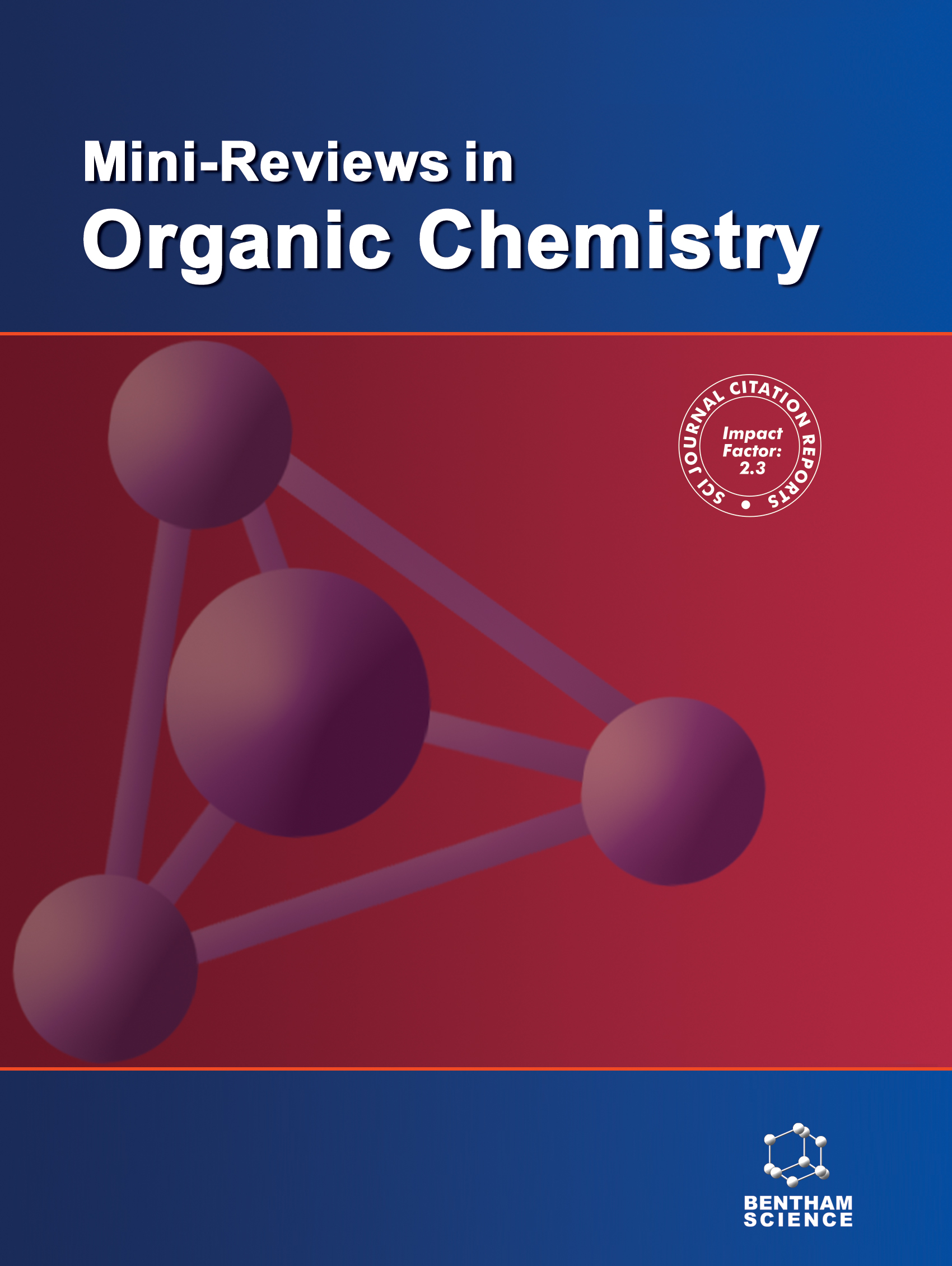- Home
- A-Z Publications
- Mini-Reviews in Organic Chemistry
- Previous Issues
- Volume 14, Issue 4, 2017
Mini-Reviews in Organic Chemistry - Volume 14, Issue 4, 2017
Volume 14, Issue 4, 2017
-
-
Bioconjugation of Ionophore Antibiotics: A Way to Obtain Hybrids with Potent Biological Activity
More LessAuthors: Michal Antoszczak and Adam HuczynskiPolyether antibiotics (ionophores) represent a large group of lipophilic compounds which are able to form complexes with the metal cations and transport them across the lipid membranes. This process disturbs the intercellular Na+/K+ concentration gradient and intracellular pH and leads to the mitochondrial injuries, cell swelling, vacuolization and finally to apoptosis process. For this reason, ionophores are commonly used in Read More
-
-
-
Multi-target Activities of Selected Alkaloids and Terpenoids
More LessA majority of the world’s population continues to use traditional natural medicines based on the established knowledge of local plants for the treatment of various disease states. Often the same plant is recognized having several traditional uses. For the past few decades, the idea of "one drug, one activity, one disease" has dominated drug discovery in Western medicine, the so-called “magic bullet” approach. However, thi Read More
-
-
-
Natural Products Based Ayurvedic Formulations: Chemical Cons tituents and Treatment in Neurodegenerative Disorders#130;
More LessAuthors: Ammu Muraleedharan, Gaurav Joshi and Raj KumarNeurodegenerative diseases are linked with high morbidity and mortality rates. Medical science has made considerable progress in understanding the mechanisms associated with the development of the neurodegenerative diseases. Each neurodegenerative disease is associated with precise pathways of cell death with its own mechanisms that lead to the development of novel therapeutic strategies for each case. In spite of v Read More
-
-
-
Polypharmacology of Natural Products Harnessed from the Ocean
More LessAuthors: Mahomoodallly M. Fawzi and Mooneesamy H.M. ShannenThe ocean covers about 75% of earth’s surface and harbours an infinite source of potential pharmacologically active organic metabolites which are yet to be explored. With the increase of noncommunicable and infectious diseases threatening public health and a dearth of existing drugs, researchers are constantly in the quest for novel bioactive template compounds from natural products. This mini-review aims at bringin Read More
-
-
-
Polypharmacology of Aconitum and Delphinium sp. Diterpene Alka loids: Antiarrhythmic, Analgesic and Anti-Inflammatory Effects
More LessUp to now, the polypharmacology of diterpene alkaloids isolated from Aconitum and Delphinium sp. has been extensively studied. From 1998 to 2014, more than 400 new diterpene alkaloids were isolated from Nature. Pharmacological researches have indicated that many diterpenoid alkaloids are the main bioactive components which have arrhythmogenic, local anesthetic, antiarrhythmic, curariform, analgesic, hypot Read More
-
-
-
Curcumin: Structure-Activity Relationship Towards its Role as a Versatile Multi-Targeted Therapeutics
More LessAuthors: Manika Awasthi, Swati Singh, Veda P. Pandey and Upendra N. DwivediCurcumin, a polyphenolic pigment of turmeric, is one of the very promising natural products that have been extensively investigated from both the biological and structural point of view. It has been shown to possess activity towards variety of targets at cellular and molecular levels that provide a basis for its use against multiple human diseases. In recent decades, it has been subjected to various pharmacological, biochemical an Read More
-
-
-
Flavonoids as Multi-Target Compounds in Drug Discovery
More LessAuthors: L. Scotti, H. Ishiki, F.J.B. Mendonça Júnior, R.M.D. Cruz, J.F. Tavares, M.F.F.M. Diniz, J.M. B. Filho and M.T. ScottiWith the aim of offering patients a more effective drug therapy and with few side effects, it was believed in the perfect and unique interaction of the bioactive compound and the receptor or target macromolecule. This concept has changed, and multifunctional compounds show greater efficiency, particularly in the therapy of complex diseases, with a sum of origin. Among these ills, we quote: neurodegenerative diseases Read More
-
-
-
Multi-target Pharmacological Effects of Platycodin D
More LessAuthors: Zhong-rong Zhang and Chun W. ChanPlant secondary metabolites are considered as a valuable source to identify promising lead compounds for developing novel drugs. Platycodin D is regarded as one of the major bioactive compounds in medicinal plant Platycodon grandiflorum, which attracts researchers to study its therapeutic effect recently. This paper reviews the latest research of biological and pharmacological activities of platycodin D. In vitro and in vivo ex Read More
-
Volumes & issues
-
Volume 22 (2025)
-
Volume 21 (2024)
-
Volume 20 (2023)
-
Volume 19 (2022)
-
Volume 18 (2021)
-
Volume 17 (2020)
-
Volume 16 (2019)
-
Volume 15 (2018)
-
Volume 14 (2017)
-
Volume 13 (2016)
-
Volume 12 (2015)
-
Volume 11 (2014)
-
Volume 10 (2013)
-
Volume 9 (2012)
-
Volume 8 (2011)
-
Volume 7 (2010)
-
Volume 6 (2009)
-
Volume 5 (2008)
-
Volume 4 (2007)
-
Volume 3 (2006)
-
Volume 2 (2005)
-
Volume 1 (2004)
Most Read This Month
Article
content/journals/mroc
Journal
10
5
false
en


